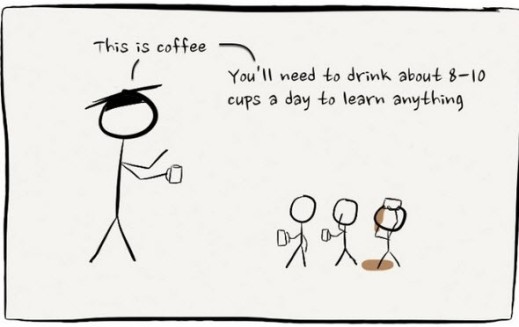
[image credit: http://errantscience.com/]
As this module draws to a close, I thought I would reflect back on some of the key things I have learnt along the way and hopefully some changes that I will adopt and use in my own practice. Lesson number one: Coffee really is a very important factor in my learning style! Which is why I have picked the cartoon I have for this post.
A couple of notes on the art of blogging and reflective writing to begin with. At the start of the module, I was slightly dreading the idea of having to write a blog post each week, but over the course of this module I have really seen the value in it. It has been quite cathartic to reflect sometimes, it has helped to make sense of things sometimes outside of the Moodle walls. I had never written a blog on my own, I had only contributed to community blogs, which in a way felt a slightly safe venue for blogging, this felt a little more exposed. Although I do know that my statistics have been low for my blog 🙂
It can be a bit daunting when it is all on you, and knowing where to start can be tricky. Thankfully our module leader towards the beginning of this module posted some useful resources about reflective writing. One of the main approaches I took away and adopted to some extent from reading the resources was that it can help to frame the writing as an interview. I have tried this approach by posing a question in some of my blog titles and then using the posting to bring together my thoughts into a kind of answer. Which brings me onto my first change that I would make, if I find myself writing a blog again, this is a very useful technique. Not for every post, but certainly it has been a very useful tool for organising and approaching a blog post. Often your mind wonders and you can find yourself diverting on tangents. Importantly this technique gives you a focus and a bit of a starting point and more importantly an end point. It is important to sometimes remember and think about the point/purpose of reflection. In this sense I am grateful to our module leader steering us towards Jenny Moons model for reflection: http://skillsforlearning.leedsbeckett.ac.uk/preview/content/models/06.shtml
Images, while they do not necessarily gain you marks, they are an important part of online communication these days. They draw the eye and I have noticed that often when having a quick flick through some of my fellow BOE’rs blogs, often it is the ones that have a pretty image that I will be drawn to. For instance Jordan Gambles blog: https://jgamblesite.wordpress.com I noticed has quite a good look and feel to his blog. Design as well as content is important, and I think if I had more time, this is something that I would change, I would pay more attention to the lay out and design of my blog. So I hope that this image meets with approval- it has certainly made me chuckle. Errant science is definitely a blog that I would recommend.
There are a lot of blog posts about blog writing, but I think this one from the Kate Cowan from The Guardian http://www.theguardian.com/culture-professionals-network/culture-professionals-blog/2011/nov/17/top-tips-successful-blog has a lot of tips. Which again if I had more time I would recommend. Interestingly she speaks about encouraging interaction. When I started this module, this was something that terrified me! But I can actually really see the enormous value in this, the comments that I have received from tutors and fellow students have really helped me to trust my ideas. The questions help you to frame your ideas as well, and these are really nothing to be scared of, they can be brilliant learning tools. So the another thing that I would change would be to make more time to read and reflect on other peoples blog postings and draw that into my blogging experience. This is really a key theme in terms of this module and in particular the ideas we looked at in terms of engaging in a community of inquiry not just in our virtual learning environment but through the blogging process as well.
What will you change? the title of my last blog post actually came from one of the first student units we participated in. It was a review question that #Teamdigliterati used. Which I think is a very useful evaluation and reflection tool. This is something that I think I will try to employ more in my own practice. To me it is a rather important idea for thinking about the impact of sessions for students. I thought this question was good, as firstly it is a ingenious way that one group has decided to get people to reflect on their teaching and ask what they would do differently in light of some of the discussions and activities that they have had you do. Very good practice in itself: a) promotes reflection, b) constructivist learning style and helps to cements learning.Secondly I find it is never a bad question to ask yourself after a teaching session…. what went well, what went badly and what would I do differently….. Even if you do not always write down these reflections. it is still good to think about.
Many of the themes of this module; particularly around the ideas of digital literacy, the visitor and residents models, and designing inclusive curriculum. Many of these themes have for me reinforced the way we view learners, they are not a homogeneous group of people. Education, learning and teaching is always going to be a developing field as it is not possible for it to be an exact science. And that actually, that is OK! You will probably never know everything, knowledge is definitely one thing but having an aptitude to learn is possibly a more important skill, with the knowledge that it is OK if sometimes not everything is perfect and sometimes ideas/theories don’t always work in practice 100% and need adapting.
This module has really made me think about the possibilities of podcasting and its use in my teaching more. I really enjoyed hearing voices deliver some of the content. When we used it in our unit, it was really nice to hear some of my fellow students voices. It makes the experience feel more personal, which is very difficult to build through discussion forums and the like. It is not really a tool I had considered using before this module. This whole unit around the idea of online social presence has made me question a few aspects of my work, in terms of some of the online courses we produce and are they online courses without regular interactions from tutors? I think podcasts and vodcasts might help a little to bring some of our materials more to life.
Gamification, while I do feel some scepticism about it. I do now see some merits there are elements of games that I can see helping motivation. Now I think about gamification…. I see elements of it everywhere. For instance a couple of weeks ago wordpress congratulated me on my 10th post and showed me a little winners cup! I think sometimes for me the concept is a little tied up in the online world in my head, but actually if you broaden out, you realise that gamification is and has been used in a variety of situations. Something I will have to look into a little more, in my practice there are already a few elements of gamification that I employ- for instance in our induction treasure hunts, there are winners who receive a prize.
So as this module draws to a close, I would like to say I will continue blogging, but I am making no firm promises on that front…. lets just see what next few months hold in store. I would like to think that I will try though, as I say, I do see its value as a reflection tool!

